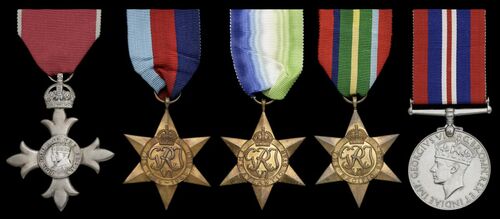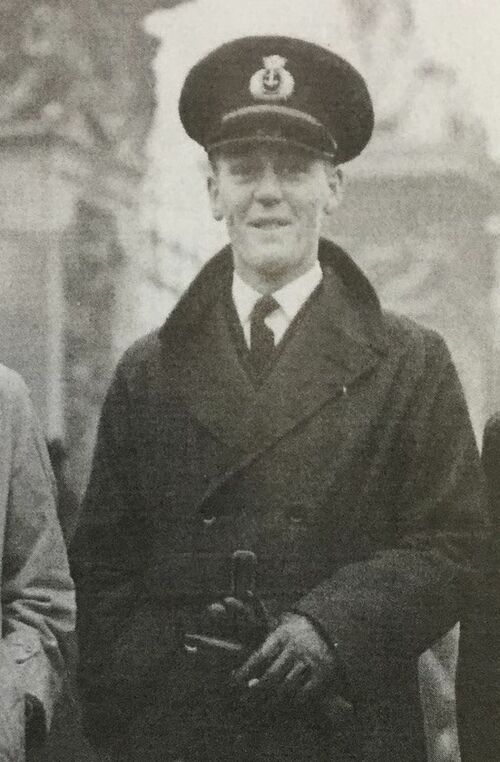Auction: 23001 - Orders, Decorations and Medals
Lot: 330
'We were about 40 ft. from the ship's side when the 3rd Officer [Granville Drayton] came running along the fore-deck from the focs'le-head shouting "Wait for me, wait for me!" He dived over the side and we picked him up. At the same time there was another man on the focs'lehead shouting, but there was nothing we could do because out of the five or six who got away into the boat, only three were able to row.
Slowly the ship drew ahead of us whilst we struggled to keep clear of burning sea. We heard some screams for help and rowed over and pulled out of the water a fireman who was terribly burned, so much so that when we pulled him into the boat, the skin from his body and arms came off in our hands like gloves, and he was in a very bad way indeed. Eventually we heard two other cries for help and found in the water an Able Seaman who was clothed and not burned. Shortly after we picked up a pumpman in the same condition. We tried to pursue the ship, looking for survivors, but it was an impossible task because those in the boat were so gravely injured and collapsing, leaving only three to row against the wind and sea. So we stopped rowing and found the first apprentice terribly burned, so much so that his hands had to be freed from the oars with scissors.
The 3rd Officer and I attended to the wounded and were horrified at the extent of their injuries. There seemed no further signs of life anywhere so we hoisted sail and set course for Trinidad. This time, the fireman who had been in such agony all night, died, and within minutes the second steward who had suffered terrible abdominal wounds and burns also passed away. I went over to him and lifted the blanket covering him and noticed the whole of his stomach badly injured and exposed. He had been very patient during the night and the only thing he complained of was the cold. Both these men were committed to the deep. We had been sailing for an hour or two when the Second Mate called me. He had been badly burned and severely injured below the waist. He wanted water which I gave him, but even then I knew it was hopeless and a few minutes later he passed away, and as I covered him up with a blanket I noticed that the senior apprentice's life was also drawing to a close.
About midday he died having been very badly burned all over his body; and had been so very brave trying to keep up the morale of the rest of the men by singing. The most pathetic thing about the whole tragedy was the extreme youth of these lads, which was uppermost in my mind as I committed them to the deep.
We continued our voyage, in utter despair and sadness … '
(Chief Officer Thomas Finch, G.M., recalls the terrible ordeal suffered by the handful of survivors who got away from the blazing inferno of their torpedoed tanker, the San Emiliano.)
The outstanding Second World War 'George Cross action' M.B.E. group of five awarded to Second Officer G. R. Drayton, Merchant Navy
A victim of the U-155, his ship, the tanker M.V. San Emiliano - laden with high octane fuel - burst into a ferocious fireball from stem to stern, an inferno in which most of the ship's company suffered a terrible end
Just a dozen men managed to get away in a lifeboat, some of them severely burnt, a case in point being 17-year-old apprentice Donald Owen who, despite his fearful injuries, pulled heartily on one of the boat's oars for two hours before collapsing - his burnt hands had to be cut away from the oar
He was awarded a posthumous George Cross and the eight men who survived the ordeal were likewise decorated or commended, including the award of Third Officer Drayton's M.B.E. and two George Medals, thereby likely gaining the accolade of most-decorated lifeboat in the annals of the Merchant Navy
Their story was subsequently featured in the World at War television series but of particular interest in respect of Drayton's role is the fact his privately printed memoirs are today held at the Imperial War Museum
The Most Excellent Order of the British Empire (M.B.E.), Civil Division, Member's 2nd type breast badge, in its Royal Mint case of issue; 1939-45 Star; Atlantic Star; Pacific Star; War Medal 1939-45, extremely fine (5)
M.B.E. London Gazette 20 July 1943. The original recommendation states:
'He displayed great courage and coolness, remaining on board until forced by the flames to jump overboard. Later, he was of great help to the Chief Officer in the boat.'
Granville Richard Drayton was born in Scunthorpe, Lincolnshire on 6 April 1921 and completed his education at Trinity House, Hull before obtaining an apprenticeship in the Brown, Atkinson & Co. shipping line.
He subsequently joined the Eagle Oil & Shipping Co. and his first wartime appointment was on the Atlantic run in the S.S. Blairesk but he was severely wounded when the ship was attacked by enemy aircraft off Scotland in August 1940. Hospitalised and then sent home for an extended period of recovery, he finally returned to duty as a Third Officer in the tanker M.V. San Emiliano in September 1941. And he was likewise employed at the time of her loss to the U-155 on the 9 August 1942.
Having departed Swansea in April 1942, the San Emeliano - laden with 11,500 tons of high octane aviation fuel - was bound from Trinidad to Cape Town when, on the 9 August, she was hit by two torpedoes fired by the U-155 and immediately burst into flames. A brief summary of events is to be found in a U.S. Navy report, based on the accounts of her eight survivors, the remaining 40 having been killed or mortally wounded:
'The ship was being conned by the Third Mate [Granville Drayton], who had the watch, but the Master was on the bridge. The weather was clear, slight sea running, wind East force 2 to 3, visibility good, no moonlight. At the time of attack the lights of the Red Cross Ship Newfoundland were visible, about 10 miles distant on the starboard bow.
The first torpedo struck on the starboard side of numbers hold, 15 feet below the water line. The explosion seemed to split the ship in two, and gasoline was thrown over the entire ship. About 30 seconds later a second torpedo hit in starboard in number 3 hold and ignited the gasoline which had been strewn over the ship which immediately became a raging inferno. The first torpedo made a hissing noise as it approached the ship. No distress signals could be sent. There was no opportunity to offer a counter offensive as the aft gunners were enveloped in flames.
The crew numbered 48 and all but 12 were burnt to death before there was any opportunity to abandon ship. One lifeboat was launched with eight survivors, and four other members of the crew dived overboard, were picked up by the lifeboat; but were so severely burned these four died within a short time. The eight survivors were picked up by the General Thomas S. Jessup on 10 August and landed at Paramaribo on the 11th. Planes of the U.S Army Air Force dropped supplies and medicine to the survivors and directed the rescue vessel to the lifeboat.
The U-boat, which was seen only for a moment, was over 800 feet long, painted a dark blue, with a light grey conning tower, which had a dark blue band near its top.'
The harrowing accounts of those who survived - and much besides - may be found on this website:
https://www.benjidog.co.uk/MiscShips/San%20Emiliano.php
By way of conclusion, their suffering is perhaps summarised by the closing words of the Thomas Finch, the senior surviving officer:
'Before I was put under sedation, the captain [of the General Jessup] asked me what to do with the life-boat, and I told him to sink it as it had been such a boat load of misery, despair, and death, and I wanted no more to do with it. I learnt later that I could have sold it and with the cash I could have clothed the survivors.'
Postscript
Repatriated and sent on furlough, Drayton was invested with his M.B.E. at Buckingham Palace.
He returned to sea in another tanker - the M.V. San Ambrosio - in December 1942 and remained likewise employed - latterly as Second Officer - until November 1943.
His final wartime appointment was in yet another tanker - the San Roberto - but, as revealed in a medical report dated in December 1945, memories of the terrible events of August 1942 were still taking their toll on him. The report recommended he obtain a discharge on medical grounds, or:
'The alternative to this would be that you remain on shore for a period of approximately 12 months, during which time you should obtain psychological treatment.'
Drayton accepted the former recommendation and, it appears, trained in land management as a second career. He is recorded as working at the Paddockhurst Estate in Balcombe, Sussex as late as 2005.
Sold with a quantity of original documentation, including wartime correspondence, the recipient's Eagle Oil & Shipping Co. Certificate of Service and his membership book for the Navigator and Engineer Officers' Union; the correspondence includes details of the above cited medical report from December 1945 and his captain's report from the M.V. San Ambrosio, dated 23 July 1943
Subject to 20% VAT on Buyer’s Premium. For more information please view Terms and Conditions for Buyers.
Sold for
£700
Starting price
£280







